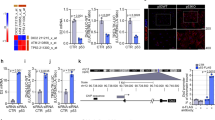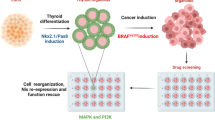Abstract
It is well known that thyroid disease is more frequent in women than in men; however, the molecular basis for this gender-based difference is still poorly understood. The activation of phosphoinositide 3-kinase (PI3K), through different mechanisms including loss of the PTEN tumor suppressor, is being increasingly recognized as a major player in the development of thyroid neoplastic lesions. Loss of Pten in the mouse thyroid results in a significant increase in the thyrocyte proliferative index, which is more prominent in the female mice. In this study, we show that 52% of the Pten−/− female mice, but only 12% of the males, develop follicular adenomas by 1 year of age. In addition, 50% of female mutants, but only 35% of males older than 1 year of age develop invasive, and often metastatic, follicular carcinomas. Mutant females have a significantly shorter overall survival compared with male mutants. Hormonal manipulation experiments established a direct role of estrogens in controlling the increased thyrocyte proliferation index in mutant females. Furthermore, while genetic ablation of one Cdkn1b allele accelerated the development of neoplastic lesions, it also abolished the gender differences in survival and reduced the difference in neoplastic lesion development rate, underlining a key role of p27 in mediating estrogen action in the thyroid follicular cells. These data, based on a clinically relevant model of thyroid follicular carcinoma, provide, to the best of our knowledge, for the first time in vivo evidence that circulating estrogens are directly responsible for the increased female susceptibility to thyroid disease, at least on activation of the PI3K pathway, and provide new insights into the gender-based differences characterizing thyroid neoplastic disorders.
This is a preview of subscription content, access via your institution
Access options
Subscribe to this journal
Receive 50 print issues and online access
$259.00 per year
only $5.18 per issue
Buy this article
- Purchase on Springer Link
- Instant access to full article PDF
Prices may be subject to local taxes which are calculated during checkout





Similar content being viewed by others
References
Chen GG, Vlantis AC, Zeng Q, van Hasselt CA . (2008). Regulation of cell growth by estrogen signaling and potential targets in thyroid cancer. Curr Cancer Drug Targets 8: 367–377.
Foster JS, Fernando RI, Ishida N, Nakayama KI, Wimalasena J . (2003). Estrogens down-regulate p27Kip1 in breast cancer cells through Skp2 and through nuclear export mediated by the ERK pathway. J Biol Chem 278: 41355–41366.
Garcia-Rostan G, Costa AM, Pereira-Castro I, Salvatore G, Hernandez R, Hermsem MJ et al. (2005). Mutation of the PIK3CA gene in anaplastic thyroid cancer. Cancer Res 65: 10199–10207.
Hou P, Ji M, Xing M . (2008). Association of PTEN gene methylation with genetic alterations in the phosphatidylinositol 3-kinase/AKT signaling pathway in thyroid tumors. Cancer 113: 2440–2447.
Hou P, Liu D, Shan Y, Hu S, Studeman K, Condouris S et al. (2007). Genetic alterations and their relationship in the phosphatidylinositol 3-kinase/Akt pathway in thyroid cancer. Clin Cancer Res 13: 1161–1170.
Jhiang SM, Sagartz JE, Tong Q, Parker-Thornburg J, Capen CC, Cho JY et al. (1996). Targeted expression of the ret/PTC1 oncogene induces papillary thyroid carcinomas. Endocrinology 137: 375–378.
Kiyokawa H, Kineman RD, Manova-Todorova KO, Soares VC, Hoffman ES, Ono M et al. (1996). Enhanced growth of mice lacking the cyclin-dependent kinase inhibitor function of p27(Kip1). Cell 85: 721–732.
Knauf JA, Ma X, Smith EP, Zhang L, Mitsutake N, Liao XH et al. (2005). Targeted expression of BRAFV600E in thyroid cells of transgenic mice results in papillary thyroid cancers that undergo dedifferentiation. Cancer Res 65: 4238–4245.
Kumar A, Klinge CM, Goldstein RE . (2010). Estradiol-induced proliferation of papillary and follicular thyroid cancer cells is mediated by estrogen receptors alpha and beta. Int J Oncol 36: 1067–1080.
Lacroix L, Nocera M, Mian C, Caillou B, Virion A, Dupuy C et al. (2001). Expression of nicotinamide adenine dinucleotide phosphate oxidase flavoprotein DUOX genes and proteins in human papillary and follicular thyroid carcinomas. Thyroid 11: 1017–1023.
Libutti SK . (2005). Understanding the role of gender in the incidence of thyroid cancer. Cancer J 11: 104–105.
Lu C, Zhao L, Ying H, Willingham MC, Cheng SY . (2010). Growth activation alone is not sufficient to cause metastatic thyroid cancer in a mouse model of follicular thyroid carcinoma. Endocrinology 151: 1929–1939.
Manole D, Schildknecht B, Gosnell B, Adams E, Derwahl M . (2001). Estrogen promotes growth of human thyroid tumor cells by different molecular mechanisms. J Clin Endocrinol Metab 86: 1072–1077.
Miller KA, Yeager N, Baker K, Liao XH, Refetoff S, Di Cristofano A . (2009). Oncogenic Kras requires simultaneous PI3K signaling to induce ERK activation and transform thyroid epithelial cells in vivo. Cancer Res 69: 3689–3694.
Pohlenz J, Maqueem A, Cua K, Weiss RE, Van Sande J, Refetoff S . (1999). Improved radioimmunoassay for measurement of mouse thyrotropin in serum: strain differences in thyrotropin concentration and thyrotroph sensitivity to thyroid hormone. Thyroid 9: 1265–1271.
Rajoria S, Suriano R, Shanmugam A, Wilson YL, Schantz SP, Geliebter J et al. (2010). Metastatic phenotype is regulated by estrogen in thyroid cells. Thyroid 20: 33–41.
Sodre AK, Rubio IG, Galrao AL, Knobel M, Tomimori EK, Alves VA et al. (2008). Association of low sodium-iodide symporter messenger ribonucleic acid expression in malignant thyroid nodules with increased intracellular protein staining. J Clin Endocrinol Metab 93: 4141–4145.
Suzuki H, Willingham MC, Cheng SY . (2002). Mice with a mutation in the thyroid hormone receptor beta gene spontaneously develop thyroid carcinoma: a mouse model of thyroid carcinogenesis. Thyroid 12: 963–969.
Vasko VV, Saji M . (2007). Molecular mechanisms involved in differentiated thyroid cancer invasion and metastasis. Curr Opin Oncol 19: 11–17.
Vitagliano D, Portella G, Troncone G, Francione A, Rossi C, Bruno A et al. (2006). Thyroid targeting of the N-ras(Gln61Lys) oncogene in transgenic mice results in follicular tumors that progress to poorly differentiated carcinomas. Oncogene 25: 5467–5474.
Vivacqua A, Bonofiglio D, Albanito L, Madeo A, Rago V, Carpino A et al. (2006). 17beta-estradiol, genistein, and 4-hydroxytamoxifen induce the proliferation of thyroid cancer cells through the G protein-coupled receptor GPR30. Mol Pharmacol 70: 1414–1423.
Wang Y, Hou P, Yu H, Wang W, Ji M, Zhao S et al. (2007). High prevalence and mutual exclusivity of genetic alterations in the phosphatidylinositol-3-kinase/akt pathway in thyroid tumors. J Clin Endocrinol Metab 92: 2387–2390.
Yeager N, Brewer C, Cai KQ, Xu XX, Di Cristofano A . (2008). mTOR is the key effector of PI3K-initiated proliferative signals in the thyroid follicular epithelium. Cancer Res 68: 444–449.
Yeager N, Klein-Szanto A, Kimura S, Di Cristofano A . (2007). PTEN loss in the mouse thyroid causes goiter and follicular adenomas: insights into thyroid function and Cowden disease pathogenesis. Cancer Res 67: 959–966.
Acknowledgements
We thank the Animal Housing and the Histotechnology and Comparative Pathology Facilities of Albert Einstein College of Medicine. This study was supported by the AECC Core Grant, and by NIH grants to ADC (CA97097 and CA128943) and SR (DK15070 and DK20595).
Author information
Authors and Affiliations
Corresponding author
Ethics declarations
Competing interests
The authors declare no conflict of interest.
Rights and permissions
About this article
Cite this article
Antico-Arciuch, V., Dima, M., Liao, XH. et al. Cross-talk between PI3K and estrogen in the mouse thyroid predisposes to the development of follicular carcinomas with a higher incidence in females. Oncogene 29, 5678–5686 (2010). https://doi.org/10.1038/onc.2010.308
Received:
Revised:
Accepted:
Published:
Issue Date:
DOI: https://doi.org/10.1038/onc.2010.308
Keywords
This article is cited by
-
Maternal High Estradiol Exposure is Associated with Elevated Thyroxine and Pax8 in Mouse Offspring
Scientific Reports (2016)
-
Expression of estrogen and progesterone receptors across human malignancies: new therapeutic opportunities
Cancer and Metastasis Reviews (2015)
-
Modeling Anaplastic Thyroid Carcinoma in the Mouse
Hormones and Cancer (2015)
-
Modulation of Sodium Iodide Symporter in Thyroid Cancer
Hormones and Cancer (2014)
-
Altered thyroid hormone profile in offspring after exposure to high estradiol environment during the first trimester of pregnancy: a cross-sectional study
BMC Medicine (2014)



